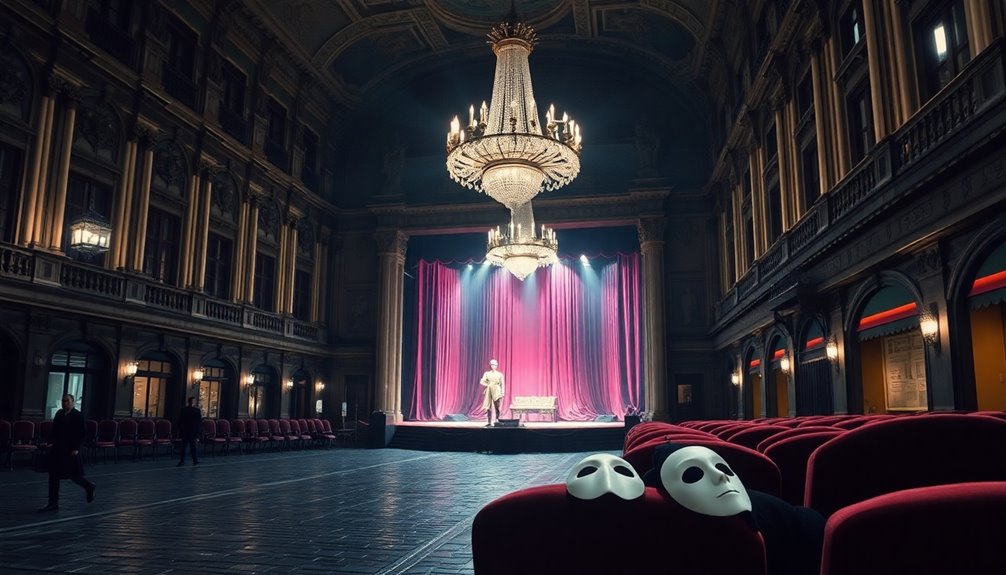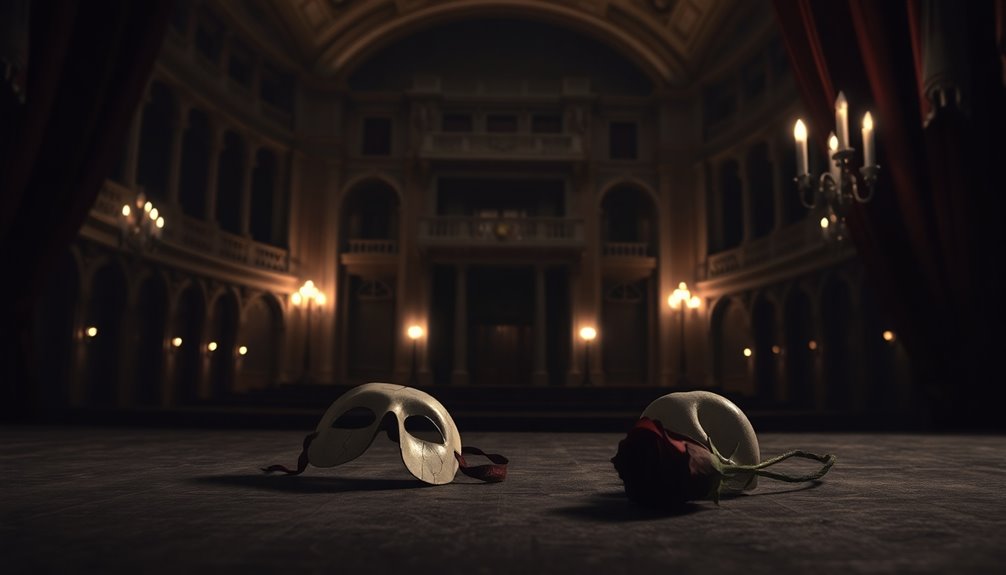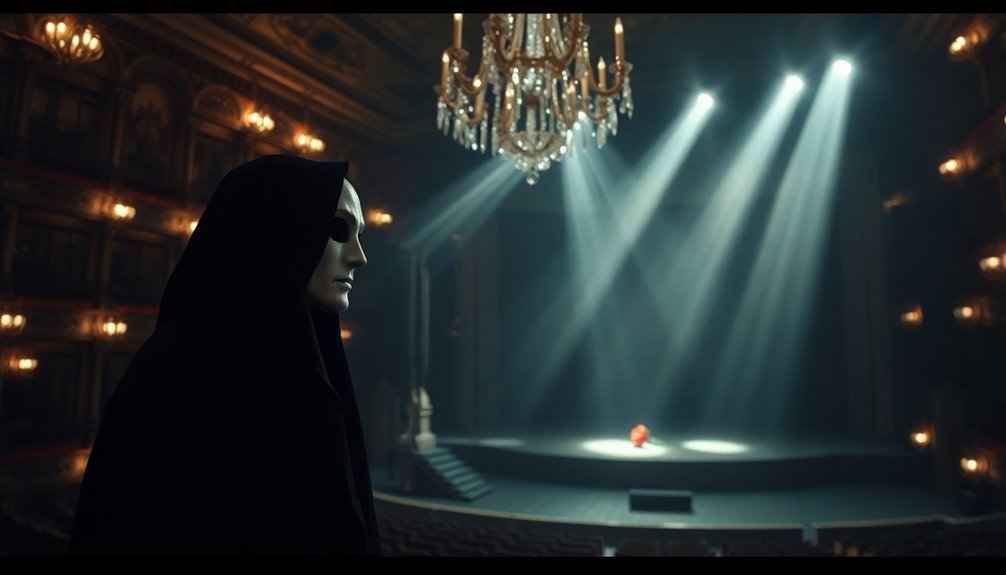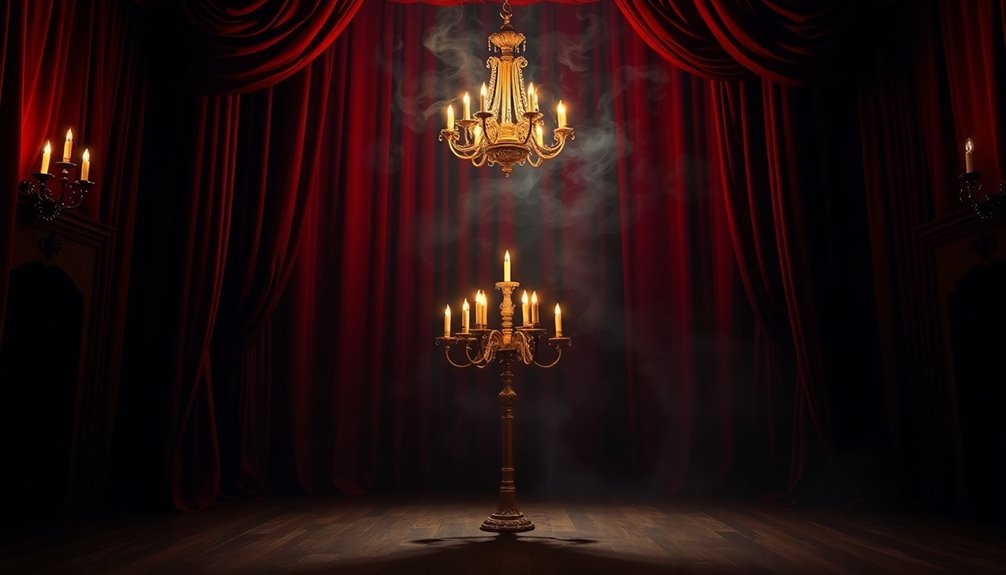In *The Phantom of the Opera*, you'll find a mesmerizing tale of love and obsession between the talented soprano Christine Daaé and the mysterious Phantom, Erik, who haunts the Paris Opera House. After a series of chaotic events driven by Erik's desperate need to secure Christine's performances, you witness the tragic consequences of their entangled fates. The novel explores deep themes of identity and societal rejection, revealing the complexities of human emotions that continue to resonate today. There's much more to discover about this haunting story.
History Behind the Novel

When you explore the history behind *The Phantom of the Opera*, you'll discover that Gaston Leroux, once a law student and journalist, crafted this iconic tale after facing personal setbacks, including a gambling loss that stripped him of his inheritance.
His experiences in crime reporting shaped the novel, which first appeared serialized in 1909 in *Le Gaulois* before its 1910 book release. This work exemplifies how post-WWII disillusionment influenced literature in the early 20th century, reflecting a broader cultural response to collective action and the fight against oppression.
Set in the stunning Palais Garnier opera house in Paris, the story draws inspiration from a real chandelier accident in 1896.
Leroux's fascination with mystery and Gothic themes, influenced by authors like Edgar Allan Poe and Sir Arthur Conan Doyle, gave the novel its suspenseful edge.
Though initial reviews were mixed, its popularity soared, leading to numerous adaptations. The haunting setting of Paris Opera serves as a backdrop that enhances the story's ambiance and deepens the narrative.
Plot Summary
As the story unfolds in *The Phantom of the Opera*, you'll find yourself immersed in the life of Christine Daaé, a gifted soprano whose enchanting voice captures the attention of both the opera audience and a mysterious figure lurking beneath the Palais Garnier.
Chaos ensues after the death of a stagehand, with Erik, the Phantom, threatening the opera's directors to secure Christine's performances. This tension mirrors the psychological drama that unfolds in Agatha Christie's *Murder on the Orient Express*. The atmosphere in the opera house echoes the Gothic settings found in classic literature, enhancing the mystery surrounding the characters.
Meanwhile, her childhood friend, Raoul de Chagny, grows jealous of Erik's influence, believing Christine has been visited by the Angel of Music.
As Erik's obsession intensifies, he abducts Christine during a performance, prompting Raoul and the Persian to rescue her.
Ultimately, Christine faces a heart-wrenching choice between love with Erik or freedom with Raoul, leading to tragic consequences. This tale of forbidden love echoes the themes found in many romantic sagas of the Victorian era. The struggle for autonomy and independence amidst societal expectations resonates throughout the narrative.
Epilogue

In the epilogue, you see the lasting legacy of the Phantom as his tragic story resonates through literature.
Erik's complex character and the themes of love and obsession continue to impact readers and inspire countless adaptations. The exploration of psychological tension in Erik's character deepens the narrative, making his struggles even more relatable. The unresolved emotional depth invites you to reflect on the haunting consequences of societal rejection and the nature of true love. Furthermore, the themes of shame and love explored in Baldwin's work echo the struggles faced by Erik, highlighting the universal quest for acceptance and understanding. In this way, the Phantom's story aligns with the experiences of immigrant communities depicted in literature, emphasizing resilience amid adversity.
Legacy of the Phantom
Although the tale of *The Phantom of the Opera* concludes with tragedy, its legacy continues to thrive, enchanting audiences around the world.
The story's themes of love and obsession resonate deeply, particularly through Erik, the Phantom, a character who embodies the tortured artist archetype. His fleeting moments of happiness before his death evoke sympathy, sparking discussions about love's complexities and the pain of isolation.
Andrew Lloyd Webber's iconic 1986 musical has further cemented this legacy, being the longest-running show in Broadway history.
Your fascination with Erik's character has fueled a vibrant fan community and ongoing scholarly interest, inspiring countless adaptations, analyses, and reinterpretations in contemporary culture.
The Phantom's story remains timeless, engaging hearts across generations.
Impact on Literature
While *The Phantom of the Opera* weaves a tale of love and tragedy, its impact on literature extends far beyond its pages.
This iconic novel has reshaped the Gothic romance genre, introducing the tragic anti-hero in Erik, whose complex nature captivates and unsettles.
The themes of love, obsession, and the duality of beauty and monstrosity resonate deeply, sparking critical discussion and creativity across generations.
Its influence is evident in various adaptations, including the renowned 1986 musical.
- Inspires countless reinterpretations
- Popularizes the tragic anti-hero archetype
- Explores profound themes of love and loss
- Fuels critical literary analysis
- Introduces Gothic elements to mainstream culture
This rich legacy guarantees The Phantom of the Opera remains a cornerstone of literary exploration.
Characters
The characters in "The Phantom of the Opera" weave a complex tapestry of love, obsession, and tragedy.
Erik, the Phantom, is a deformed musical genius who becomes fixated on Christine Daaé, manipulating her emotions and instilling fear to win her affection. His relentless pursuit of her affection mirrors the dark allure of obsession seen in co-dependent relationships. Like Otto and Anna Quangel's acts of resistance against tyranny, Erik's fixation reveals how small acts of defiance can turn into dangerous obsession.
Christine, a gifted soprano, sees Erik as the Angel of Music, initially unaware of his darker tendencies. As her innocence fades, she grapples with the reality of her feelings.
Enter Raoul de Chagny, Christine's wealthy childhood friend, who rekindles their bond and becomes increasingly jealous of Erik's hold over her. His determination to rescue Christine from the Phantom's grasp adds tension, showcasing the conflicting emotions that drive these characters toward their fates in the haunting opera house. Ultimately, their struggles reflect the resilience of women facing adversity as they navigate love and manipulation in a world filled with darkness.
Themes

Love and obsession pulse at the heart of "The Phantom of the Opera," driving the narrative and shaping the characters' fates. Erik's intense infatuation with Christine leads him to manipulative and destructive actions, illustrating the dangerous side of love.
You'll see themes of identity and isolation, especially through Erik's tragic backstory, as his deformity forces him into the shadows. The conflict between beauty and monstrosity emerges, challenging societal perceptions as Erik's brilliance clashes with his appearance. The story embodies the struggles similar to those faced in systemic racism as individuals confront societal rejection and isolation, often leading to betrayal and murder in their desperate attempts for acceptance.
- The impact of rejection on Erik's psyche
- The blurring lines between myth and reality
- The tragic consequences of obsessive love
- The role of societal perceptions in shaping identity
- The duality of character motivations and actions
- The story reflects the complexities of systemic oppression faced by individuals marginalized by society.
Music
Music weaves a haunting thread through *The Phantom of the Opera*, shaping emotions and guiding the narrative.
You'll find that Christine Daaé's exceptional singing voice captivates everyone, marking her rise to fame under Erik's shadow.
The Phantom, a musical genius, composes haunting melodies that reflect his complex feelings and obsession with Christine.
This tension between beauty and monstrosity unfolds through contrasting musical motifs—while Christine's angelic voice enchants, Erik's dark compositions reveal his tormented soul.
The operatic setting of the Paris Opera House enhances these themes, immersing you in a world where music conveys love, obsession, and tragedy.
As you explore deeper, you'll see how integral music is to the characters' journeys and the unfolding drama.
Mystery
As you explore *The Phantom of the Opera*, a sense of mystery envelops you, drawing you into the enigma of the elusive Phantom, Erik.
The narrative unfolds as a detective story, with you piecing together clues about Erik's identity and motives. Suspense builds through suspicious events, like the death of stagehand Joseph Buquet and the Phantom's ominous threats to the opera managers.
- Erik's mysterious appearances and disappearances
- Christine Daaé's manipulation and loyalty demands
- Chilling confrontations between love and obsession
- The opera house as a labyrinthine backdrop
- Rumors swirling among the cast and crew
Each element weaves a complex tapestry of intrigue, keeping you captivated by the Phantom's chilling presence.
Gothic Horror
Although *The Phantom of the Opera* presents a love story at its core, it deeply embodies the essence of Gothic horror through its exploration of fear, isolation, and the grotesque.
You encounter Erik, a mysterious figure whose physical deformities and tragic past evoke both fear and pity. His lair beneath the Paris Opera House, filled with torture devices and hidden passages, amplifies the atmosphere of dread.
Themes of madness and revenge surface as Erik's obsession with Christine leads him to commit violent acts, paralleling iconic Gothic monsters.
The story contrasts beauty and monstrosity, forcing you to grapple with societal perceptions of appearance and Christine's internal conflict.
The haunting tone and Erik's ghost-like presence draw you into the chilling depths of human nature.
Romance
At the heart of *The Phantom of the Opera*, the intricate love triangle between Christine Daaé, the Phantom (Erik), and Raoul de Chagny reveals the complexities of desire and obsession.
You see, Christine's initial adoration for Erik, whom she believes to be her Angel of Music, contrasts sharply with her childhood bond with Raoul.
- Erik's love is possessive and manipulative.
- Christine grapples with her feelings for both men.
- Raoul represents safety and conventional love.
- The tension escalates as Erik threatens those Christine loves.
- Ultimately, Christine chooses Raoul, symbolizing her rejection of Erik's dark allure.
This poignant struggle highlights the devastating effects of obsession and the search for true love.
Critical Reception
When you look at the early reception of *The Phantom of the Opera*, you'll notice critics were split, particularly over the melodrama and the Phantom's unmasking.
Yet, as it found its way into newspapers, its popularity surged, revealing a more favorable view than originally thought.
Adaptations like Andrew Lloyd Webber's musical have since transformed the story, boosting its legacy and drawing in new fans.
Early Reception Perspectives
Gaston Leroux's *The Phantom of the Opera* sparked a diverse range of reactions upon its initial release in France, with critics split in their evaluations.
The early reception highlighted various critical perspectives that showcased the novel's complexity as a mystery novel.
- Some appreciated its intrigue and suspense.
- Others criticized it as lacking compared to Leroux's earlier works.
- The serialized format from 1909 to 1910 built anticipation and readership.
- The New York Times review pointed out dissatisfaction with the Phantom's identity reveal.
- Recent findings suggest the novel had a more favorable reception than previously thought.
This mix of opinions reflects the challenges Leroux faced in engaging his audience while establishing the Phantom's legacy.
Adaptation Influence on Popularity
Although *The Phantom of the Opera* faced mixed reviews upon its release, adaptations of the story have played a crucial role in boosting its popularity.
The 1925 silent film featuring Lon Chaney brought Erik's haunting tale to the silver screen, capturing audience attention despite its directorial changes.
However, it was Andrew Lloyd Webber's 1986 musical that truly transformed the narrative into a cultural phenomenon. Winning numerous awards and becoming the longest-running musical on Broadway, it created a lasting legacy that resonated worldwide.
This success led to countless international productions, although significantly, the musical has never been performed professionally in France.
Such divergence in reception highlights how adaptations can elevate a story, often reshaping its legacy in the process.
Adaptations
Adaptations of *The Phantom of the Opera* have captivated audiences for generations, each bringing a unique interpretation to the timeless story. From silent films to stage musicals, these adaptations explore the complex relationships between Christine and Erik in different ways.
- The 1925 silent film showcased Lon Chaney's haunting performance as the Phantom.
- Andrew Lloyd Webber's 1986 musical is the longest-running show in Broadway history.
- The 2004 film adaptation introduced Gerard Butler as Erik and Emmy Rossum as Christine.
- International stage adaptations have flourished, though the musical hasn't been performed professionally in France.
- Each adaptation emphasizes different facets of the story, from romance to Gothic horror.
These variations keep the tale fresh and engaging for new audiences.
Author's Background
The rich tapestry of *The Phantom of the Opera* owes much to the life experiences of its creator, Gaston Leroux.
Initially, he ventured into law but shifted to journalism after losing his inheritance to gambling. Working for L'Écho de Paris, he honed his storytelling skills through critiques of dramas and court case reports.
His extensive travels and fascination with mystery, inspired by authors like Edgar Allan Poe and Sir Arthur Conan Doyle, shaped his narrative style.
In 1909, he serialized *Le Fantôme de l'Opéra*, drawing on the haunting atmosphere of the Palais Garnier opera house, influenced by real events like the notorious chandelier accident.
This blend of personal experience and inspiration culminated in a timeless tale of love and obsession.
Setting and Influence
Set against the lavish backdrop of the Paris Opera House in the 1880s, *The Phantom of the Opera* immerses you in a world where beauty and darkness coexist.
Gaston Leroux's vivid portrayal of this iconic venue, inspired by real events, enhances the narrative's tension and intrigue.
- The opulence of the opera house contrasts sharply with Erik's lair beneath it.
- Gothic architecture amplifies the story's eerie ambiance.
- A chandelier accident serves as a chilling reminder of danger.
- Themes of love, obsession, and isolation unfold amidst artistic splendor.
- Leroux's experience as a theatre critic enriches the depiction of musical performances.
This setting not only shapes the characters but also reflects the complexities of the human soul.
Symbolism in the Novel
Symbolism weaves a rich tapestry throughout *The Phantom of the Opera*, enhancing the emotional depth of the narrative.
The chandelier in the Paris Opera House embodies both the beauty and danger of the Phantom's presence, its dramatic fall foreshadowing chaos. Erik's mask reveals his hidden identity and societal rejection due to his deformity, illustrating the stark duality between appearance and reality.
The underground lair symbolizes Erik's isolation and obsession, contrasting sharply with the vibrant world above. Meanwhile, Christine's evolving awareness reflects the loss of innocence, revealing the harsh truths of love and manipulation.
Together, these symbols deepen your understanding of the characters' struggles, enriching the complex themes woven throughout the story.
Legacy of the Phantom
The legacy of the Phantom can't be overstated, as it continues to shape popular culture through countless adaptations and interpretations.
From Andrew Lloyd Webber's iconic musical to classic film renditions, the story resonates with audiences today just as it did over a century ago.
You'll find that the themes of love and isolation in Erik's character remain powerful, influencing many works across various media.
Cultural Impact Analysis
While many stories fade into obscurity, *The Phantom of the Opera* has left an indelible mark on popular culture, evolving into a timeless tale that resonates across generations.
The character of Erik, the Phantom, has become emblematic of love, obsession, and societal rejection, influencing countless adaptations and interpretations.
- Andrew Lloyd Webber's musical remains a Broadway staple.
- Over 30 films have brought the Phantom's story to life.
- The 1925 silent film established visual tropes still used today.
- The novel has shaped the horror genre and anti-hero narratives.
- Its themes inspire art, music, and fashion globally.
You can see how this enthralling tale continues to engage and inspire, proving that its legacy is far from over.
Adaptations and Interpretations
From its haunting melodies to its tragic romance, *The Phantom of the Opera* has inspired a multitude of adaptations that reinterpret its story for new audiences.
The 1925 silent film featuring Lon Chaney set a visual standard for Erik's character with its groundbreaking special effects and makeup.
In 1986, Andrew Lloyd Webber's musical took the world by storm, becoming one of Broadway's longest-running shows and introducing the tale to countless fans. This adaptation won multiple awards and has been translated internationally, showcasing its broad appeal.
The 2004 film further cemented its legacy by highlighting the romantic and gothic elements.
With various adaptations in ballet, novels, and television, the Phantom's story continues to resonate and evolve across artistic mediums.
Conclusion
As you close the pages of "The Phantom of the Opera," shadows of the opera house linger in your mind, the haunting melodies echoing in the corridors of your imagination. You can almost feel the chill of the underground lairs and the warmth of Christine's voice, intertwining in a tragic dance. The legacy of love and obsession weaves through your thoughts, leaving you spellbound, pondering the thin line between beauty and darkness that defines the human heart.



